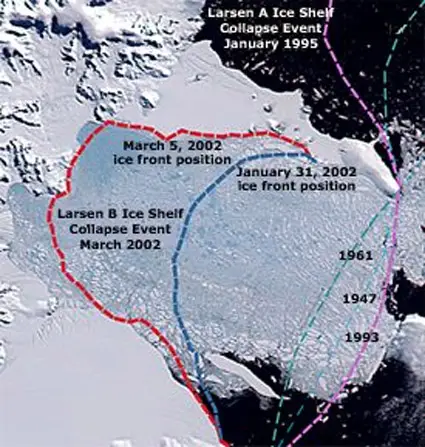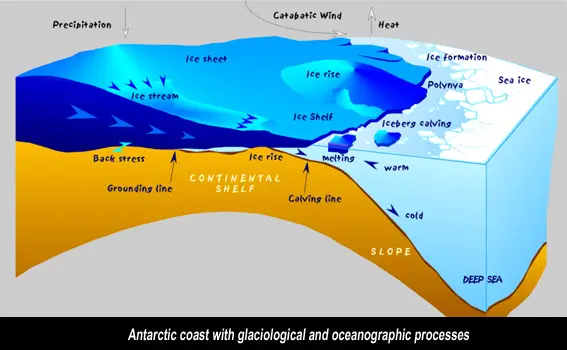In January 1995, two events on the Larsen Ice Shelf attracted public attention: the calving of a 70 – by 25-kilometre iceberg from the Larsen B; and the disintegration of the remainder of the Larsen A. The disintegration is considered by many scientists to be closely related to climate change. The break-up pattern in the Larsen A, in which 2,000 square kilometres disintegrated into small icebergs, was at that time an unprecedented observation.
In 2002, satellites recorded an even larger disintegration than what occurred in 1995. Between 31 January and 5 March 2002, approximately 3,250 square kilometres of the Larsen Ice Shelf B shattered, releasing 720 billion tons of ice into the Weddell Sea. It was the largest single disintegration event in 30 years of ice shelf monitoring. Preliminary studies of sediment cores suggest that it may have been this ice shelf’s first collapse in 12,000 years.

Image: Extent of Larsen Ice Shelf retreat. MODIS image courtesy of Ted Scambos, National Snow and Ice Data Center, University of Colorado, Boulder.
An ice shelf is a thick, floating platform of ice that forms where a glacier or ice sheet flows down to a coastline and onto the ocean surface. Ice shelves range in thickness from about 100 to 600 meters, and some shelves last for thousands of years or longer. They fringe the continent of Antarctica, and occupy a few fjords and bays along the Greenland and Ellesmere Island coasts. The boundary between floating ice shelf and the grounded (resting on bedrock) ice that feeds it is called the grounding line. When the grounding line retreats inland, water is added to the ocean and sea level rises.
While calving or disintegrating ice shelves don’t raise ocean level themselves, the resulting glacier acceleration does, and it poses a direct threat to coastal communities. More than 100 million people currently live within 1 metre of sea level.Greenland contains enough ice to raise sea levels by 7 metres (23 feet), and Antarctica holds enough ice to raise sea levels by about 57 metres (187 feet). At their seaward edge, ice shelves periodically calve icebergs, some the size of a small U.S. state or European country.

The Ross Ice Shelf is the main outlet for several major glaciers from the West Antarctic Ice Sheet. This single ice sheet contains enough above-sea-level ice to raise global sea level by 5 metres (16 feet). A marked warming trend is evident in the Antarctic Peninsula, with spectacular loss of ice shelves, and movement of glaciers which must cause a rethink of the stability of the larger West Anatarctic Ice Sheet.
As mentioned elsewhere, climate like other complex systems do not always vary in a smooth fashion, and sudden changes can occur over wide areas. Critical levels, or thresholds may be reached in a system whereupon drastic, and disastrous results can occur. How sure can we be that the collapse of the Larsen Ice Shelf isn’t additional pressure to trigger a snowball earth?
See Also
